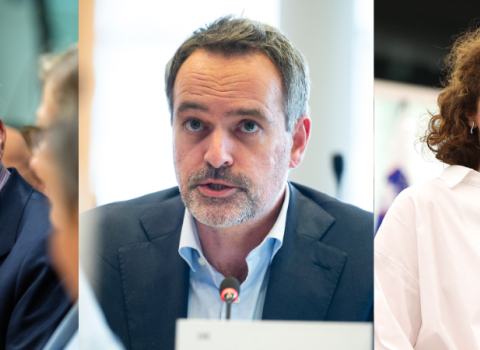Project offers blueprint to develop more homegrown deep tech in Europe

ATTRACT Final Conference. From the left: Lina Gálvez Muñoz, Member of the European Parliament; Sergio Bertolucci, Chair, R&D&I Committee (IC) of ATTRACT; Jean-David Malo, Acting Director, ERA and Innovation, DG RTD, European Commission; Mali Baum, Board Member, EIC and Founder, WLOUNGE; Maryline Fiaschi, CEO, Science|Business. Photo Credits: ATTRACT.
Europe has struggled to leverage its spending on research and development to create commercially-attractive products. The ATTRACT project, which held its final conference in early July, offers some evidence of what works and what doesn’t as food for thought for policymakers charting the future of EU research funding.
The project is “a source of potential gems on which we should build,” Jean-David Malo, acting director, ERA and Innovation at the European Commission’s DG RTD told the packed conference in Brussels. The EU has learned several lessons from the project, he said, including the value of cascade funding (channelled through trusted research organisations) for startups, the importance of scientific rigour in the selection of projects and of coaching entrepreneurs all along their journeys.
He added that the ATTRACT project has inspired the European Commission, which manages European research funding, to introduce an element of an “innovation challenge” in future second-round funding to ensure that there are sufficient funds available to help the most successful startups scale up and grow.
Starting in 2018, ATTRACT invested €60 million of EU public money in 170 promising R&D projects related to detection and imaging technology. Relying on existing research infrastructure leaders, efficient funding procedures and collaboration with public and private investors, the project later focused on18 projects with the potential for strong scientific, industrial and societal applications. This resulted in the launch of eight startups, some of which are already in their second round of financing.
Europe needs a deep tech turnaround
The ATTRACT final conference took place amid soul-searching among EU member states, which prominent economists have criticised for failing to create a supportive environment in Europe for startups and scale-ups, in so-called deep tech (technologies based on scientific discoveries) or otherwise.
In September 2024, former Italian Prime Minister Mario Draghi published a report that argued that Europe’s inability to compete with the United States and China risked becoming existential. “My concern is not that we will suddenly find ourselves poor and subservient to others. We still have many strengths in Europe,” he said when he presented the report last year. “It is that, over time, we will inexorably become less prosperous, less equal, less secure and, as a result, less free to choose our destiny.”
That’s because Europe is increasingly dependent on technologies invented elsewhere, which may even be subject to “kill switches” in imported technology tools that allow other nations to remotely discontinue services to users in Europe.
At the conference, Lina Gálvez Muñoz, a Member of the European Parliament, said the international context for Europe has dramatically worsened since the ATTRACT project began. “The world gets bigger and bigger, and Europe is getting smaller and smaller” by comparison, she said, referring both to geopolitics and to Europe’s dependence on the services of global tech giants.
Fredrik Erixon, founding director of the European Centre for International Political Economy (ECIPE), a Brussels-based think tank, agreed, noting that R&D levels in Europe, as a percentage of gross domestic products, are one-third to one-half lower than in the United States, China or Japan, and that the money Europe spends results in far fewer business stars.
Erixon criticised research funding policies in Europe, which he said “routinely dismissed” the importance of capital markets in funding startups and scale-ups in favour of public funding that is inherently less efficient. “Capital markets help coordinate talent and resources around better outcomes,” he said. “That’s what capital markets do.”
Cascading funding proves effective
Public money can also be used more efficiently, the ATTRACT project showed. Rather than requiring would-be entrepreneurs to apply directly for EU research grants—a time-consuming, notoriously bureaucratic process—the Commission funded a consortium of trusted research organisations, led by CERN and including the European Molecular Biology Laboratory (EMBL), the European Southern Observatory, a business organisation, and two universities: ESADE Business School in Barcelona and Aalto University in Helsinki. The consortium, in turn “cascaded” most of the funding - €55 million out of a total of €60 million - to individual entrepreneurs employing scientific rigour, but less paperwork, speeding up the process.
Mali Baum, an award-winning serial entrepreneur, investor and startup mentor who has worked in New York and Silicon Valley and now sits on the board of the European Innovation Council, said Europe still needs to do more to court private capital. “Not everything can come from the public sector,” she said.
Sergio Bertolucci, a particle physicist who chairs the ATTRACT R&D&I Committee, said European governments could also do a better job of channelling existing funding to promising entrepreneurs by pooling resources in a pan-European fund for deep tech rather than disbursing their research budgets individually. He also said Europe needs to make good on its promises to simplify procedures for research funding and “complete the single market”, which hinders businesses in Europe today as much as it helps them.





 A unique international forum for public research organisations and companies to connect their external engagement with strategic interests around their R&D system.
A unique international forum for public research organisations and companies to connect their external engagement with strategic interests around their R&D system.